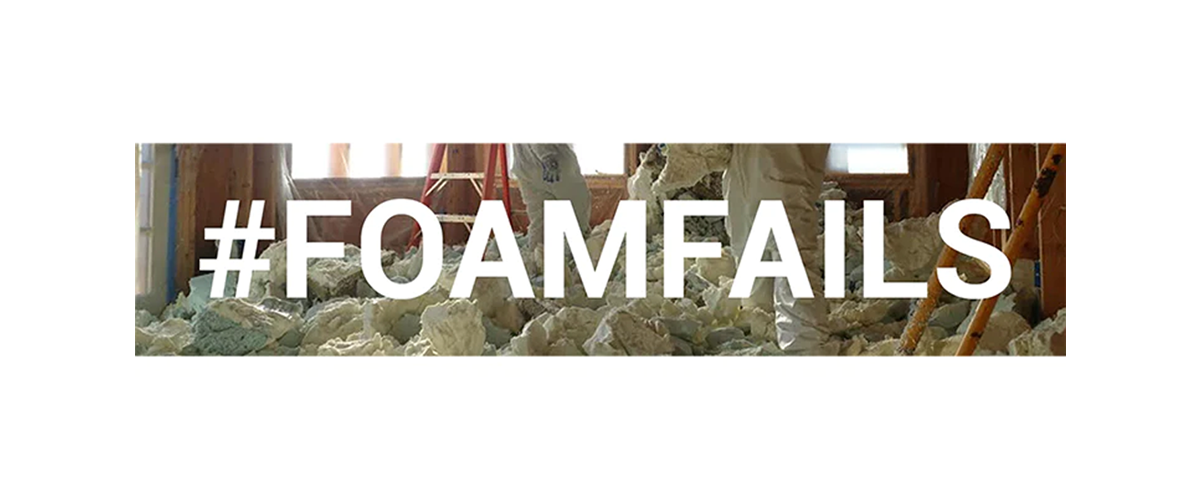Is it really too much to ask that our thermal insulation not be a fire accelerant? After all, thermal insulation can (and should) continuously and completely envelop the buildings we occupy. Foam feeds fires. Foam fails. (See the 13 reasons Foam Fails, here.)
For an idea of what it means to be an accelerant, take a look at the video below, produced by The Cellulose Insulation Manufacturers Association, that compares the burn characteristics of cellulose, fiberglass and foam.(The video’s long version is here.) The spray foam insulation produces a flashover in 44 seconds – a supersonic jet in fire acceleration by thermal insulation.
As described by a 1989 OSHA technical memorandum:
“Rigid polyurethane and polyisocyanurate foams will, when ignited, burn rapidly and produce intense heat, dense smoke and gases which are irritating, flammable and/or toxic. As with other organic [carbon based petrochemical] materials the most significant gas is usually carbon monoxide. Thermal decomposition products from polyurethane foam, consist mainly of carbon monoxide, benzene, toluene, oxides of nitrogen, hydrogen cyanide, acetaldehyde, acetone, propene, carbon dioxide, alkenes and water vapor.”
“One of, the major safety precautions to be taken around organic [carbon based petrochemical] foams is to prohibit sources of ignition such as open flames, cutting and welding torches, high intensity heat sources and smoking.”
Therefore, foam can be particularly hazardous during construction or renovation, as it is often exposed.
 Shanghai 2010
Shanghai 2010
In 2010 foam ignition caused by welding in Shanghai China, produced a horrific tragedy, claiming the lives of at least 53 and injuring more than 70 others.
The South China Morning Post reported:
“It was being retrofitted with exterior insulation panels in a pilot energy conservation scheme by the local government. But the flammable polyurethane foam has been identified as a major contributory factor behind the scale of the disaster.”
Foam can have chemical fire retardants in them but they don’t actually prevent the foam from burning - see this new report, Flame retardants in building insulation: a case for re-evaluating building codes, here. However, the retardants do poison our environment (See #1 Dangerous Toxic Ingredients).
In November 2012 a Dubai skyscraper - as blogged by Lloyd Alter in Treehugger here - actually burned down its facade, accelerated by its foam/metal sandwich panels.
And of course, we must mention the horrific tragedy of the Grenfell Tower fire, in London, in June 2017, which killed 72 and injured 70 more. While the tower was a horror of mismanagement and violations, the foam-based cladding was determined to be a significant contributor to the tragedy.
Given all this - it’s important to remind ourselves that there are choices. What other possible insulation materials might we use?
All help prevent fire spread.
Foam not only feeds fires, but when spray foam is improperly installed it can actually start the fire. As reported by Martin Holladay in 2011 on GreenBuildingAdvisor, the results can be devastating:
"The Massachusetts Division of Fire Safety (DFS) is investigating the causes of three house fires that were ignited while insulation contractors were installing spray polyurethane foam.
According to Tim Rodrique, the director of the DFS, investigators suspect that the fires were caused by the exothermic reaction that results from the mixing of the two chemicals used to make spray foam."
Cape Cod, 2011. photo: Dave Curran
Foam doesn't help firefighting. Foam insulation makes firefighting more hazardous and difficult.
We have choices.
For all the reasons foam fails, see our post, Foam Fails.




